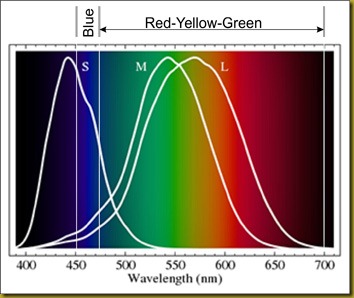Looking at the Colour Blue is Seriously Hard Work
For those that remember some of the stuff they were taught in high school you will remember that the sensory part of the eye’s retina is made of cones and rods. The rods operate in dull light and detect brightness, or, if you like it said another way, see in shades of grey. At night when you look up at the moon and stars the eye is using mainly the rods to ‘see’ with.
Unlike rods the cones operate in good light and they are sensitive to colour, or more correctly, the colour wavelengths.
There are way more rods than cones with the ratio of rods to cones being something like 6:1 averaged over the seeing surface of the retina; but in the areas on the edge of the seeing surface the ratio goes up to 10:1. Because there are so many rods and they operate in low light this is how we see in the dark, and this is why you cannot make out colour in the dark—the colour-sensing cones are not operating due to the lack of light.
There are three types of cones. The most abundant cones are the long-wavelength (L) cones that detect red/orange. The next most abundant are medium-wavelength (M) cones that are sensitive to yellow/green. The third type of cones, of which we have the least, are the short-wavelength (S) cones that detect blue/violet.
In people who are colour blind, which are mostly men (because whatever it is that causes someone to be colour blind is carried by the X chromosome), their L and M cones are merged together and cannot differentiate between these wavelength colours. Colour blind people rarely (if ever) have any problems seeing and identifying blue/violet short-wavelength colours.
But back to the point of this post: Blue is hard work to “see”.

So, with so few blue S-sensing cones how come we seem to see blue without any problems, and in fact, it will often appear as though blue is really standing out when we look at it?
The reason we see blue as vivid, and often more saturated and vivid than it actually is, is because our amazing brain takes over. It knows we need help in seeing blue so it brightens and saturates the S-sensor data as it processes it. Because of this the visual decoding part of our brain ‘works’ about three times harder when we are seeing blue than it does when we are focussing on L- or M-sensor colours.
The reason that police lights in most countries are a combination of red and blue is because of this very reason. L-sensor cones, which pick up the red flashing light, are the most plentiful in our eyes, and due to the enhancement overlayed by our brains when we try to ‘see’ blue we actually see blue brighter and more vivid than it really is—also colour blind people can see blue.

Back in the days of text-only screens on computers many people used to configure their word processors to work with white text on a blue background. Note the example shown at right where the WordPerfect word processor has been configured for white text on a blue background.
It took businesses and people a while to realise the reason the incident of migraines and headaches was skyrocketing. That is was due to staring at such screens for hours working on documents and their poor old brains were basically getting burn-out processing colour data because there was so much blue having to be ‘seen’.

Then there is the Peacock with its dazzling blue neck.

